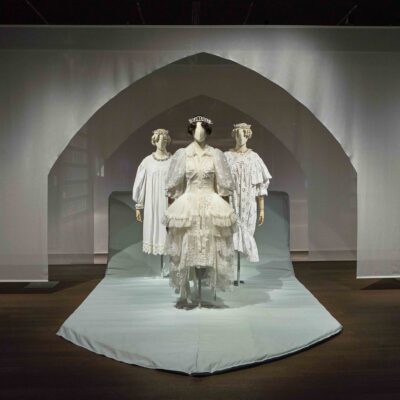
Exhibitions 21.11.2025
11.07.2022
European fashionfashion exhibition
To conceal or to reveal? A Guest Post by the team at Modemuseum Hasselt about the exhibition exploring the fashioning of the body
On February 26, 2022, Modemuseum Hasselt opened DressUndress, an exhibition that explores the relationship between the (un)dressed body and fashion. The exhibition examines how the naked or disguised body is linked to ever changing ideas and views on the notions of gender, sexuality, beauty and morality. In a journey to map this complex interplay between the human body, fashion and culture across centuries, the exhibition is divided into four overarching sub themes: Revealing, Concealing, Trompe l’oeil and Metamorphosis. These are explored through the mediums of fashion, media, film and art, as well as by means of audio guides featuring interviews that offer diverse perspectives on the (un)dressed body in relation to notions of gender, body positivity/inclusivity and religion.
The first gallery, Revealing, reflects on both the historical and contemporary meanings of revealing the body in fashion, sometimes explicitly, sometimes more nuanced, linked to social and cultural developments and notions of the body in relation to gender, beauty and even politics. From an 18th century chemise à la reine, a ‘crotch revealing’ design by Rick Owens, to creations by Helmut Lang, Lili Schreiber, Jean Paul Gaultier and Miu Miu, Revealing traces the multifaceted translations of uncovering the body from the 18th century to the present.
This exploration of revealing the body in fashion is followed by Concealing in the second gallery which seeks the significance of precisely the concealment of the body through fashion, contextualising it with notions of gender, religion and (time-related) norms and concepts. This contextualisation emphasises the diverse manifestations of covering the body- think, for example, of a 19th century day dress with a high-necked bodice that reflects the era’s attitudes towards decency and modesty, as well as a veiled look from Balenciaga’s S/S ‘22 ‘Balenciaga Clones’collection, that plays with the concepts of identity, reality and filters as a comment on the current digital era.
On the first floor, the remaining themes of Trompe l’oeil and Metamorphosis are displayed. The first explores the idea of trompe l’oeil, the creation of optical illusions of the body in fashion, which is expressed, for example, in the so-called naked dresses. The gallery displays a variety of designs by Schiaparelli, Olivier Theyskens, Alaïa, Maison Margiela and Di Petsa, alongside the noteworthy naked dress by Mugler worn by Megan Fox at the VMA’s in 2021.
This interplay between fashion, illusion and the body is extended in the gallery: Metamorphosis, which examines how the human body is modified and manipulated by the use of tools such as crinolines, corsets, bustles, etc. The gallery presents both historical silhouettes as well as translations of these fashions by designers in the 80s and 90s and the present, illustrating how the representation of the human body through fashion should be understood in relation to constantly changing social and cultural perceptions and understandings of ideals of beauty, body shape, sensuality and gender.
By means of the four overarching themes – and the additional art installations on the top floor – the exhibition explores the many manifestations of dressing and undressing the body in fashion and their diverse (cultural) significance. Throughout the exhibition, we also see the influence of co-curator Murielle Scherre, whose vision on the ‘unadulterated body’ provokes important discussions on body inclusiveness, diversity and restrictive perceptions of beauty. In doing so, the exhibition highlights fashion’s potential to reflect on our constantly changing norms and values that influence the way we look at, and dress our bodies.